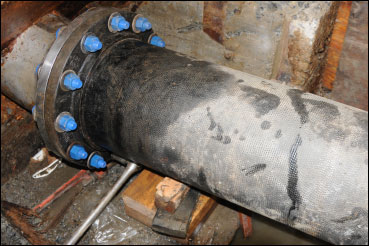 December 31, 2012 CONTACT: Chris Gilbride / Angel Roman (718) 595-6600 Department of Environmental Protection Announces Improved Maintenance Contributes to Fewest Water Main Breaks in Over a DecadeWater Pressure Management Program Has Helped Reduce Breaks by 40 Percent Since 2007
New York City Department of Environmental Protection (DEP) Commissioner Carter Strickland today announced that improved maintenance and training in the agency’s Bureau of Water and Sewer Operations have contributed to the fewest water main breaks in any year since Mayor Bloomberg took office in 2002. In 2012, there were 20 percent fewer water main breaks than the previous year. And, since DEP began a program to improve maintenance in the pressure zones within the City’s water distribution system in 2007, water main breaks are down by more than 40 percent. “There are nearly 7,000 miles of water mains running under almost every street in the five boroughs and when there is a break or leak residential life is disrupted, transportation networks are hampered, and business can be interrupted,” said DEP Commissioner Carter Strickland. “By using cutting edge technology and increased preventative maintenance 2012 saw the lowest number of water main breaks during the last decade and we will continue to focus on driving this number down even further in the coming years.” Pressure in the City’s water distribution system is largely supplied by gravity. Downward pressure from Hillview Reservoir in Yonkers, which is roughly 300 feet above sea level, forces water through tunnels and into a network of water mains in the city. Pressure in the water distribution system is then controlled by a series of regulators and valves that are designed to supply reliable pressure throughout the city. In 2007, DEP began a program to reassess the City’s different pressure zones in an effort to prevent sudden spikes in pressure that can cause water mains to leak or break. In 2010, DEP also reorganized its Valve and Regulator Repair unit to more proactively inspect equipment and make repairs which has helped minimize unintended spikes in water pressure and resulted in fewer water main breaks. This year, DEP performed more than 5,300 preventive maintenance inspections on the City’s roughly 500 water pressure regulators and rebuilt almost 90 of them. In 2011, DEP also expanded its network or remote sensors that monitor pressure at water tunnel shafts and key regulators and send a cellular signal to DEP headquarters allowing engineers to identify problems and make repairs before they damage the water distribution system. DEP now remotely monitors every pressure zone in the city. Improving pressure zone boundary maintenance is a key initiative of Strategy 2011 – 2014, DEP’s far reaching strategic plan that lays out 100 distinct initiatives to make the agency the safest, most effective, cost efficient, and transparent water utility in the nation. In 2012 there were 347 breaks in the city’s network of nearly 7,000 miles of water mains, down from a high of 632 in 2003. This year DEP averaged less than six breaks per 100 miles of pipe, well below the accepted industry average of roughly 23-25 breaks per 100 miles annually. In addition, this year DEP created a hands-on training center for Bureau of Water and Sewer Operations employees that is fully equipped with all of the features of a real city street including: sewers, catch basins, hydrants, water mains and manholes. The site also includes hundreds of feet of iron pipe, with six valves, three fire hydrants, asphalt roadbed, concrete sidewalks, catch basins, and manhole covers. The facility provides new and veteran employees with the best possible training in a safe environment that is free from the noise, distractions, and danger associated with vehicle and pedestrian traffic. Employees receive consistent training on how to safely operate equipment and perform day to day maintenance such as properly shutting down water mains, cleaning catch basins, safely flushing sewers, installing fire hydrants, and proper roadway reconstruction. The field training is also paired with two hours of classroom safety training that teaches workers about proper personal safety equipment, setting up a secure work site and all of the hazards employees face while working in New York’s busy streets. DEP manages New York City’s water supply, providing more than one billion gallons of water each day to more than nine million residents, including eight million in New York City. The water is delivered from a watershed that extends more than 125 miles from the city, comprising 19 reservoirs, and three controlled lakes. Approximately 7,000 miles of water mains, tunnels, and aqueducts bring water to homes and businesses throughout the five boroughs, and 7,500 miles of sewer lines and 96 pump stations take wastewater to 14 in-city treatment plants. DEP has nearly 6,000 employees, including nearly 1,000 in the upstate watershed. For more information, visit www.nyc.gov/dep, like us on Facebook at www.facebook.com/nycwater, or follow us on Twittar at www.twitter.com/nycwater. | ||